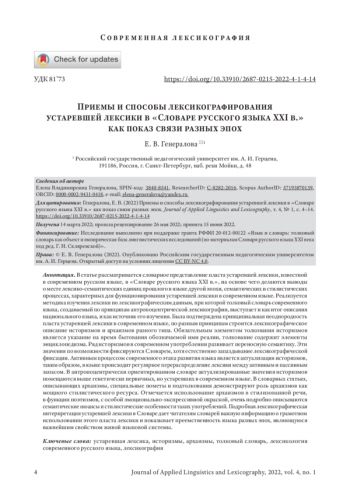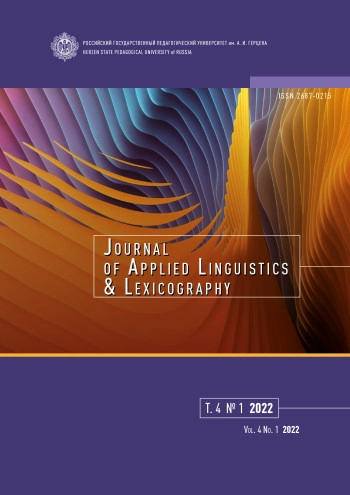В статье рассматривается словарное представление пласта устаревшей лексики, известной в современном русском языке, в «Словаре русского языка XXI в.», на основе чего делаются выводы о месте лексико-семантических единиц прошлого в языке другой эпохи, семантических и стилистических процессах, характерных для функционирования устаревшей лексики в современном языке. Реализуется методика изучения лексики по лексикографическим данным, при которой толковый словарь современного языка, создаваемый по принципам антропоцентрической лексикографии, выступает и как итог описания национального языка, и как источник его изучения. Была подтверждена принципиальная неоднородность пласта устаревшей лексики в современном языке, по разным принципам строится лексикографическое описание историзмов и архаизмов разного типа. Обязательным элементом толкования историзмов является указание на время бытования обозначаемой ими реалии, толкование содержит элементы энциклопедизма. Ряд историзмов в современном употреблении развивает переносную семантику. Эти значения по возможности фиксируются Словарем, хотя естественно запаздывание лексикографической фиксации. Активным процессом современного этапа развития языка является актуализация историзмов, таким образом, в языке происходит регулярное перераспределение лексики между активным и пассивным запасом. В антропоцентрически ориентированном словаре актуализированные значения историзмов помещаются выше генетически первичных, но устаревших в современном языке. В словарных статьях, описывающих архаизмы, специальные пометы и подтолкования демонстрируют роль архаизмов как мощного стилистического ресурса. Отмечается использование архаизмов в стилизованной речи, в функции поэтизмов, с особой эмоционально-экспрессивной окраской, очень подробно описываются семантические нюансы и стилистические особенности таких употреблений. Подробная лексикографическая интерпретация устаревшей лексики в Словаре дает читателям словарей важную информацию о грамотном использовании этого пласта лексики и показывает преемственность языка разных эпох, являющуюся важнейшим свойством живой языковой системы.
The article explores how obsolete vocabulary contained in modern Russian is presented in the Dictionary of the 21st Century Russian Language. The analysis allows to draw conclusions about the place of lexical units of the past in the language of another era. It also provides insights into the specifics of semantic and stylistic functioning of obsolete vocabulary in the modern language. The study uses the methodology that investigates the vocabulary through lexicographic data. It means that an explanatory dictionary of the modern language, created according to the principles of anthropocentric lexicography, acts both as a result of the description of the national language and as a source of its study. The study confirmed the fundamental heterogeneity of obsolete vocabulary in the modern language. The lexicographic description of historicisms and archaisms of different types is based on different principles. An obligatory element of the interpretation of historicisms is an indication of the time of existence of the reality designated by them. It contains elements of encyclopedism. A number of historicisms in modern use are developing figurative semantics. These meanings are given in the Dictionary whenever possible, although, there is naturally a delay in the lexicographic representation. The modern stage of language development is marked by the actualization of historicisms. Thus, the language is subject to a regular redistribution of vocabulary between active and passive language stock. In an anthropocentrically oriented dictionary, the actualized meanings of historicisms are placed first, i. e., before the genetically primary but obsolete in the modern language meanings. Dictionary entries describing archaisms have special marks and comments the show the role of archaisms as a powerful stylistic resource. The article describes cases of special use of archaisms in stylized speech, their function as poeticism, their special emotional and expressive coloring. A special focus is given to semantic nuances and stylistic features of such uses. Such lexicographic interpretation of outdated vocabulary in the Dictionary provides readers with important information about its appropriate use and demonstrates the continuity of the language of different eras as an important property of a living language system.
Идентификаторы и классификаторы
- Префикс DOI
- 10.33910/2687-0215-2022-4-1-4-14
- eLIBRARY ID
- 54733033





